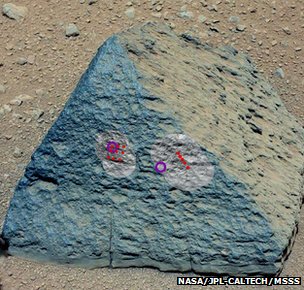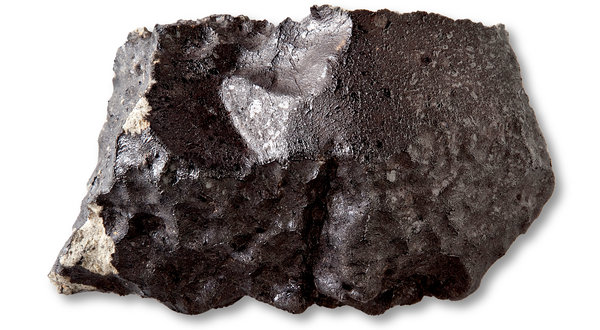NASA’s Curiosity rover finds “unusual rock”. [BBC News – Science & Environment]
NASA/JPL-Caltech image via BBC News
I’ve been contemplating this delicious headline for several days. In describing the Mars rock (dubbed Jake Matijevic after a recently deceased mission engineer), the BBC felt the need to put unusual rock in quotes. OK, The Curiosity rover found a rock isn’t headline material.
What’s interesting about this rock is its resemblance to a type of rock known on Earth, not common here but catalogued. The rock is another indication that Mars once had water. Curiosity was landed at the head of an ancient alluvial fan and has already found evidence that there was once rapidly flowing water. We want more knowledge about water on Mars — and we’re hunting specifically for proof of organic compounds that would mean that Mars once had life as well.
Buck Rogers stuff that many pooh-poohed in the 1950s. There was no way to know, and now Curiosity. Sputnik was 1957 — if you were born then, you’re now 55.
Measure that same span against the current ecological crisis on earth, the species lost, the climate change. No one has evidence that Mars once held intelligent beings or that the Martian lack of water now was a miscalculation by them. If they existed. We exist. Here, now.
____________________________________________________
Piece of the Tissint meteorite from Mars found in Morocco Natural History Museum of London photograph, via the New York Times
A piece of Mars fell to Earth last summer. It’s thought to have left Mars 700,000 years ago — about the same time that Paleolithic hands fashioned the Happisburgh handaxe here on Earth.
The Happisburgh handaxe via BBC/British Museum History of the World
The meteorite is named for the Moroccan village Tissint near where it landed. It’s only the fifth Martian meteorite known to have been seen falling. What a sight — imagine.
It plunged to Earth as a fireball that illuminated the Moroccan night, awakening soldiers and nomads with a sonic boom. Los Angeles Times
It’s not known whether the Paleolithic peoples who made the handaxe ever witnessed such a thing. They lived where the coast of England now is, there was a land bridge they could travel to what’s now Europe, the weather was hot, they lived alongside hippos. If a meteor fell they would not have been able to analyze it. The best archaeologist can only guess at their thinking.
The Tissint meteorite is largely black glass with noble gases trapped inside. It fell in a desert and was recovered before rain could have eroded it. As pure a piece of Mars as you’re likely to pick up south of Marrakesh. Scientists analyzed the the noble gases, oxygen isotopes and minerals, and the fingerprint of Mars was there.
Most of us would stare at the meteorite nearly as clueless as the Paleolithic folk. We now understand the idea of meteorite and can grasp that it came here from that red planet in the sky, but isotopes and noble gases?
We suspect that the meteorite was whacked off of Mars by something like an asteroid. The solar system seems to be as lively as a bumper-car rink with meteors, meteorites, little meteoroids, and asteroids and comets, and things that humans now fling up past Earth’s atmosphere. An asteroid is implicated in the demise of dinosaurs. I wonder whether Curiosity or its kin have traversed the site where the Tissint rock got bashed off of Mars.
____________________________________________________
The meteorite is a handsome rock, black as anthracite. Surface textures, strong details. The Happisburgh handaxe is a thing of beauty. Its shape is intentional. It has the harmony of an art — a studied, tested method of flaking shards from flint to make a sharp-edged tool.
Falling through space, caroming off other rocks, can’t match this artistry.
____________________________________________________
look further:
BBC News, Nasa’s Curiosity rover finds “unusual rock” is here.
Happisburgh handaxe
- The British Museum, BBC’s A History of the World
- front and back views on the Wikimedia Commons
- bonus link. Wikipedia has a great page on Britain’s Secret Treasures where our handaxe reigns as notably the oldest find.
ChemCam — read more about it here.



